#936 Crow mythology and archetype
Dead Crow & the Spirit Engine
by Art (Sean Arthur) Joyce
New Denver: Chameleonfire Editions, 2020
$20.00 / 9780995240148
Reviewed by Roger C. Lewis
*
 This poem is a fascinating exercise in the bending, blending, and merging of genres while at the same time assaulting the empty pretensions of narcissistic nihilism in today’s grossly politicized literary environment. Not the usual series of disjointed prose statements about the poet’s emotions, Dead Crow & the Spirit Engine is an epic narrative of thirty linked poems written in tercets framed by a prose introduction with notes at the end. It explores many layers of meaning in a time when we are told nothing means anything. Mythic characters and episodes span all creation and time. Individual passages glow with lyric intensity and individual lines can have epigrammatic force e.g. “Starvation/does vicious things to innocence” (p. 47). Dead Crow has a narrative voice that veers from grand literary eloquence to the flatly prosaic, sometimes a laconic film noir drawl with coarse diction. Other genres include fable, folktale, dream vision, dramatic monologue, soliloquy, fantasy and heroic quest.
This poem is a fascinating exercise in the bending, blending, and merging of genres while at the same time assaulting the empty pretensions of narcissistic nihilism in today’s grossly politicized literary environment. Not the usual series of disjointed prose statements about the poet’s emotions, Dead Crow & the Spirit Engine is an epic narrative of thirty linked poems written in tercets framed by a prose introduction with notes at the end. It explores many layers of meaning in a time when we are told nothing means anything. Mythic characters and episodes span all creation and time. Individual passages glow with lyric intensity and individual lines can have epigrammatic force e.g. “Starvation/does vicious things to innocence” (p. 47). Dead Crow has a narrative voice that veers from grand literary eloquence to the flatly prosaic, sometimes a laconic film noir drawl with coarse diction. Other genres include fable, folktale, dream vision, dramatic monologue, soliloquy, fantasy and heroic quest.
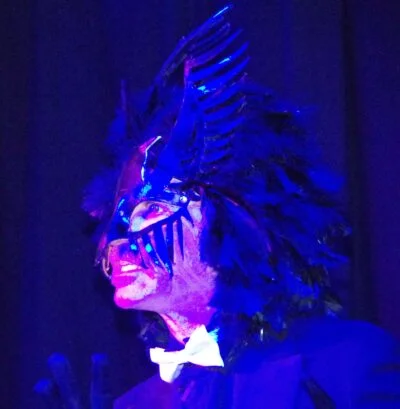
The mythic idiom is central, and must not be confused with falsehood. The truth of a myth is not its words but its patterns. It is inside, not outside, the narrative. Myths of deliverance from slavery, overthrow of tyranny, or cosmic origins of evil are true not because they reference historical events but because they are always happening. As an archetypal mythical figure, Crow is an immortal among a race of divine Makers who falls, like Satan, into a state of exile on Earth after offending them through vainglorious misuse of his powers. Though transformed from his pristine white to coal-black, and somewhat degraded, he is still a demigod and becomes a Watcher of humanity, chronicling its blunders and misdeeds without ever fully understanding its destiny. Able to participate in and influence earthly events, he cannot, however, control them. Like Loge, the Nordic trickster and god of fire, he is unreliable and unpredictable — his motto is “Who knows what I’ll do?” Like the Haida Gwaii Raven trickster, he is the master of arcane knowledge, and like Shiva-Nataraja, the multi-armed dancing Hindu god, he simultaneously creates and destroys.
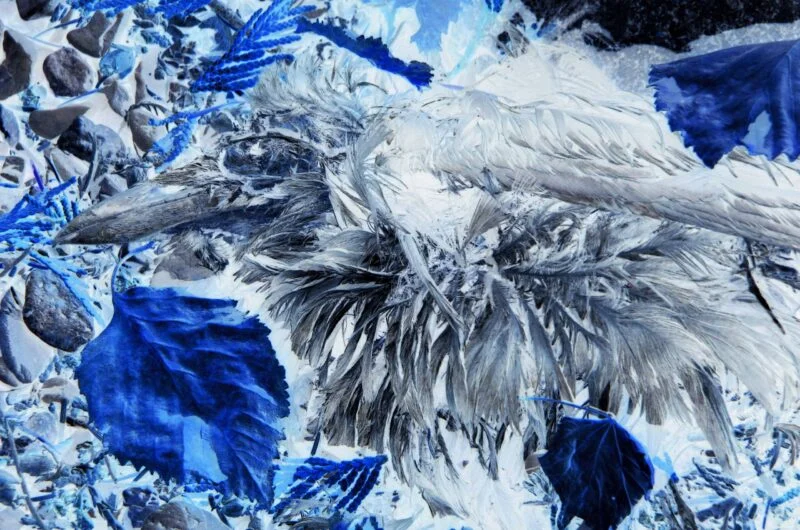
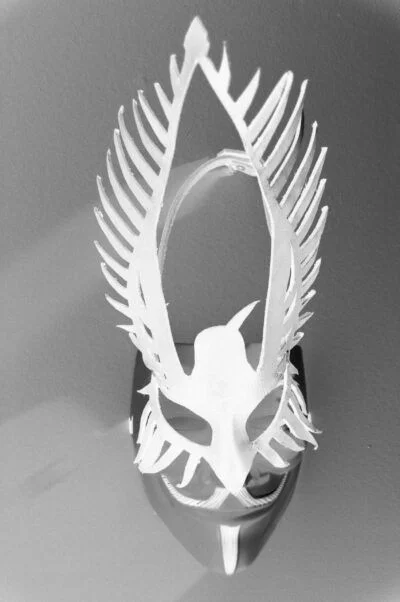
The opening poems reveal a myth of birth and origins, Crow hurled from heaven, falling like Lucifer through the universe until he lands on Mount Ararat just after the Great Flood; in The Epic of Gilgamesh version of that story it’s a raven, not a dove, that is sent out from the ark to find dry land. Crow has a symbiotic relationship with all earthly creatures — “what I am/ is a little bit of everything” (p. 14) — yet his curse is to be a lonely outsider trying to fathom the meaning of the imploding empires of history. Poem No. 6 evokes through striking imagery the voyage of Noah’s Ark, “ that timberframe box stinking/ of shit and despair” (p. 19).
In poems No. 9 & 10, love enters the narrative. As a shapeshifter, Crow takes human form as a heroic sword-making blacksmith, like Siegfried, wooing a goddess. Then he becomes the Irish deity Morrigan, a raven goddess who, like Brunnhilde, appears to dying soldiers to escort them to Valhalla. Even though he’s a natural romantic and his name is among the great lovers of history, Dead Crow is unlucky in love.
Poems No. 13 to 22 introduce the Aurora-like Dawn Crow, who changes that. She is his female counterpart as both of them were originally specimens of the White Crow Clan, dwelling before their exiles with the Makers. When Dawn arrives on Earth still pristine-white, he burns with love, seeking to share his world and being with her, shouting defiantly to the Makers, “Now she’s here, you no longer own me” (p. 32). Dawn reciprocates enthusiastically as she learns her way around her new environment, yielding to the “unstoppable urge/ of one pair of eyes to look into another” (p. 37). This running metaphor of eyes interpenetrating leads to a paradigm shift of loneliness into the transcendent love that concludes the poem (p. 65).
We encounter the mysterious Spirit Engine of the title in poems No. 25 & 26. Operated by Grandfather Raven, another variant on the Creator-Trickster and Master of “ancient erudition,” it is both mechanism and organism, metaphorically identified as a “coughing calliope” (p. 53). When Crow demands that Grandfather Raven explain this cosmic machine that keeps “the whole wheezing organ/ of eternity from collapsing” he refuses on the grounds that it is “very complicated,” arguing that, “Existence is a mystery, a gift” (pp. 50-51).
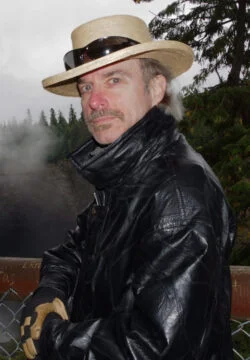
The final poems abound with resurrection and transfiguration imagery. Crow’s assignment of Watcher, which he never wanted in the first place, ended with his failure to discover the secret of the Spirit Engine. He is no longer needed on Earth by the Makers, who release him from exile. In poem No. 30, we find him united in love with Dawn Crow, “a soul finding its twin,” as they sing their “Resurrection Duet” (p. 63).
The narrative thrust of this epic structure is from the divine origins and terrestrial birth of Dead Crow through his historical involvement with Floods, the historic rise and fall of Empires, heroic quests on “the Road,” and the successful pursuit of Dawn Crow. “Working within a mythic form is another strand with which Dead Crow & the Spirit Engine was woven,” writes Joyce, “and comes with some great advantages: by freeing the content from the present, it is free to roam in all times, all places. To be about now, and not now, even as it moves both forward and backward in time.”
A work ten years in the making and based on deep scholarship, Dead Crow & the Spirit Engine presents the reader with extensive challenges and rich rewards.
*
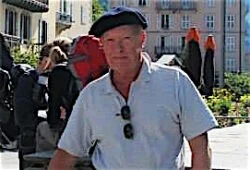
Roger C. Lewis is Professor of English Literature (Emeritus) at Acadia University, Wolfville, Nova Scotia, Canada. Dr. Lewis is the author of many books, articles and reviews. He was Co-Editor of the 10 Vol. Edition of The Correspondence of Dante Gabriel Rossetti (2002-2015), Editor of Dante Gabriel Rossetti’s The House of Life: A Variorum Edition, and Editor of The Collected Poems of Robert Louis Stevenson. He wrote Poems and Drawings of Elizabeth Siddal and Thomas James Wise and the Trial Book Fallacy. He also taught English Literature at the University of Toronto, Ryerson University, and Athabasca University. He specialized in research on and teaching of poetry and Comparative Literature. Recently he published a collection of short stories called Identity Matters: Canadian Stories. He lives with his wife Nancy and works in Silverton, where he visits frequently with his sons Scott and Cameron and their families.
*
The Ormsby Review. More Books. More Reviews. More Often.
Publisher and Editor: Richard Mackie
The Ormsby Review is a journal service for in-depth coverage of B.C. books and authors. The Advisory Board consists of Jean Barman, Robin Fisher, Cole Harris, Wade Davis, Hugh Johnston, Patricia Roy, David Stouck, and Graeme Wynn. Scholarly Patron: SFU Graduate Liberal Studies. Honorary Patron: Yosef Wosk. Provincial Government Patron since September 2018: Creative BC
“Only connect.” – E.M. Forster
One comment on “#936 Crow mythology and archetype”